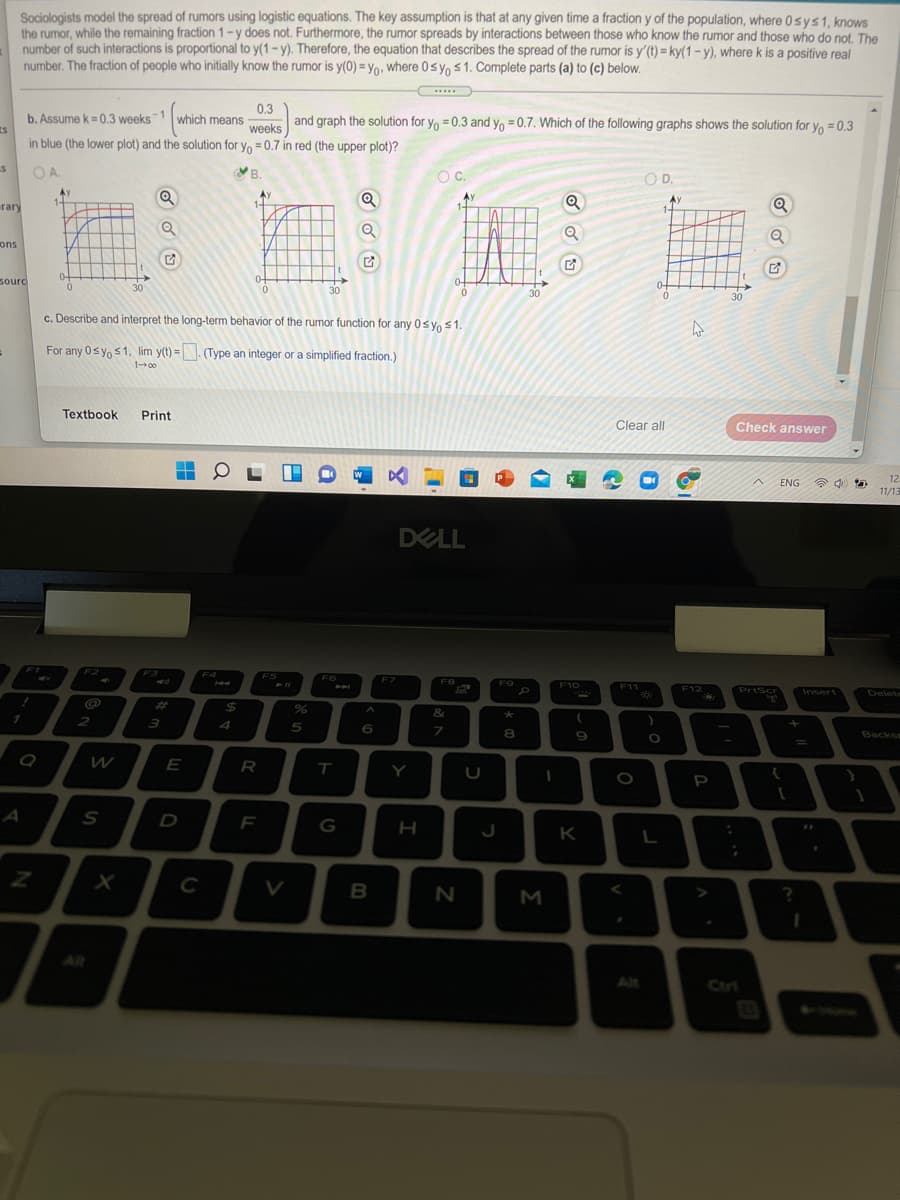Sociologists model the spread of rumors using logistic equations. The key assumption is that at any given time a fraction y of the population, where 0sys1, knows the rumor, while the remaining fraction 1-y does not. Furthermore, the rumor spreads by interactions between those who know the rumor and those who do not. The number of such interactions is proportional to y(1-y). Therefore, the equation that describes the spread of the rumor is y'(t) = ky(1-y), where k is a positive real number. The fraction of people who initially know the rumor is y(0) = Yo, where 0sy, s1. Complete parts (a) to (c) below. 0.3 and graph the solution for yo = 0.3 and yo = 0.7. Which of the following graphs shows the solution for y, =0.3 b. Assume k= 0.3 weeks which means weeks in blue (the lower plot) and the solution for yo =0.7 in red (the upper plot)? OA. VB. C. OD. rary Q Q Q ons sourd 04 0. 0- 30 0+ 0- 30 30 c. Describe and interpret the long-term behavior of the rumor function for any 0s Yo $1. For any 0sy, s1. lim y(t) = (Type an integer or a simplified fraction.) t-00 Textbook Print Clear all Check answer
Sociologists model the spread of rumors using logistic equations. The key assumption is that at any given time a fraction y of the population, where 0sys1, knows the rumor, while the remaining fraction 1-y does not. Furthermore, the rumor spreads by interactions between those who know the rumor and those who do not. The number of such interactions is proportional to y(1-y). Therefore, the equation that describes the spread of the rumor is y'(t) = ky(1-y), where k is a positive real number. The fraction of people who initially know the rumor is y(0) = Yo, where 0sy, s1. Complete parts (a) to (c) below. 0.3 and graph the solution for yo = 0.3 and yo = 0.7. Which of the following graphs shows the solution for y, =0.3 b. Assume k= 0.3 weeks which means weeks in blue (the lower plot) and the solution for yo =0.7 in red (the upper plot)? OA. VB. C. OD. rary Q Q Q ons sourd 04 0. 0- 30 0+ 0- 30 30 c. Describe and interpret the long-term behavior of the rumor function for any 0s Yo $1. For any 0sy, s1. lim y(t) = (Type an integer or a simplified fraction.) t-00 Textbook Print Clear all Check answer
Chapter6: Exponential And Logarithmic Functions
Section6.8: Fitting Exponential Models To Data
Problem 2TI: Sales of a video game released in the year 2000 took off at first, but then steadily slowed as time...
Related questions
Question
100%
Can someone explain it to me ASAP???!! Separable Differential Equations

Transcribed Image Text:Sociologists model the spread of rumors using logistic equations. The key assumption is that at any given time a fraction y of the population, where 0sys1, knows
the rumor, while the remaining fraction 1-y does not. Furthermore, the rumor spreads by interactions between those who know the rumor and those who do not. The
number of such interactions is proportional to y(1- y). Therefore, the equation that describes the spread of the rumor is y'(t) = ky(1 - y), where k is a positive real
number. The fraction of people who initially know the rumor is y(0) = yo, where 0sy, s1. Complete parts (a) to (c) below.
b. Assume k = 0.3 weeks 1
ts
in blue (the lower plot) and the solution for y, =0.7 in red (the upper plot)?
0.3
and graph the solution for y, = 0.3 and yo = 0.7. Which of the following graphs shows the solution for Vo =0.3
which means
%3D
weeks
OA.
VB.
OC.
OD.
rary
Q
ons
sourd
04
0-
0-
30
30
0-
->
30
c. Describe and interpret the long-term behavior of the rumor function for any 0sy, s1.
For any 0sy, s1, lim y(t) =. (Type an integer or a simplified fraction.)
t-00
Textbook
Print
Clear all
Check answer
12.
ENG
11/13
DELL
F2
F3
F4
FS
F6
F7
F8
F9 .
H4
F10
F11
PAL
F12
PrtScr
Insert
Delete
%23
%24
&
2
3
5
6
Backs
W
E
R
P
F
G
J
K
L
C
M
Alt
Alt
Ctrt
Expert Solution
This question has been solved!
Explore an expertly crafted, step-by-step solution for a thorough understanding of key concepts.
Step by step
Solved in 3 steps with 3 images

Recommended textbooks for you


Algebra & Trigonometry with Analytic Geometry
Algebra
ISBN:
9781133382119
Author:
Swokowski
Publisher:
Cengage


Algebra & Trigonometry with Analytic Geometry
Algebra
ISBN:
9781133382119
Author:
Swokowski
Publisher:
Cengage